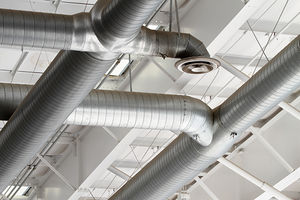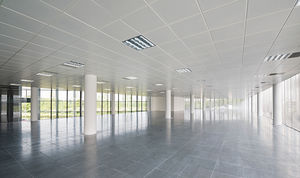 Architects, Engineers and Interior Designers are following the recent trend of installing open space ceiling environments instead of a tradition suspended or “false” ceilings. This change in aesthetic building design has raised questions about plenum energy performance and long term costs. Is this design change based on more open air concept actually improving a building’s efficiency? CISCA has completed a Life Cycle Study that compares cost and performance considerations for both types of ceiling environments in two different categories of buildings, office and retail. The study also reviewed these types of ceilings in five different geographical markets in the U.S. to show the differences in energy use, construction costs, and climate impacts. The results of the analysis are summarized below showing that suspended ceilings creating a closed air plenum are more energy and cost efficient.
Architects, Engineers and Interior Designers are following the recent trend of installing open space ceiling environments instead of a tradition suspended or “false” ceilings. This change in aesthetic building design has raised questions about plenum energy performance and long term costs. Is this design change based on more open air concept actually improving a building’s efficiency? CISCA has completed a Life Cycle Study that compares cost and performance considerations for both types of ceiling environments in two different categories of buildings, office and retail. The study also reviewed these types of ceilings in five different geographical markets in the U.S. to show the differences in energy use, construction costs, and climate impacts. The results of the analysis are summarized below showing that suspended ceilings creating a closed air plenum are more energy and cost efficient.
Initial construction costs are higher for suspended ceilings.
- First time construction costs were up to 22% higher for suspended ceilings in offices.
- First time construction costs were up to 11% higher for suspended ceilings in retail spaces.
 Suspended ceiling spaces use less energy than open ceilings spaces.
Suspended ceiling spaces use less energy than open ceilings spaces.
- Return air plenums in suspended ceilings utilizing low static pressure are more efficient at removing heat from lights and reducing air conditioning consumption.
- Higher light reflectance with a suspended ceiling vs. open area (assumed 70% vs. 50%).
Maintenance costs are lower for suspended ceilings vs. open ceilings spaces.
- Periodic duct, pipes and raceway cleaning necessary.
- Open spaces will require painting and be periodically repainted.
Energy cost savings are significant for suspended ceilings.
- Total energy savings ranged from 9% to 10.3% for the office design and 12.7% to 17% for the retail design.
- Suspended ceilings can contribute to LEED® EA credits: 0.5% reduction in energy to earn 1 point, 14% reduction earns 2 points.
Safety First
Cost and energy efficiency benefits aside another advantage of a closed air plenum created by a suspended ceiling is added safety. Reducing flammability is critical to the safety of buildings and by utilizing a suspended ceiling, a designer can create a closed air plenum which isolates air from the rest of the occupied space, thereby controlling flame and smoke in the event of a fire. This control during a fire in closed plenum can reduce fire and smoke from one part of the building spreading quickly to other parts of a building. Flammability and safety are also concerns for mechanical insulation because it is installed on equipment in plenums. Strict limits required by building codes and standards like the plenum rating for flame spread index and smoke developed index, are in place to ensure the flammability and smoke potential of mechanical insulation is very low.
 Armacell’s ArmaFlex® Ultra with FlameDefense™ technology is an exceptional choice for insulation in air plenums because it is the first elastomeric insulation Classified by UL to UL 723 at 25/50 due to its elevated resistance to burning and smoke development. ArmaFlex Ultra also meets the current IMC and IECC building codes which require that mechanical insulation products achieve specific flame and smoke ratings, and that these ratings be regularly certified by a third party lab. In the event of fire, our material will burn slower and produce less smoke, giving occupants and first responders precious extra time. With patent pending FlameDefense technology, ArmaFlex Ultra goes beyond the required building codes and international safety regulations, thus improving building safety and energy efficiency.
Armacell’s ArmaFlex® Ultra with FlameDefense™ technology is an exceptional choice for insulation in air plenums because it is the first elastomeric insulation Classified by UL to UL 723 at 25/50 due to its elevated resistance to burning and smoke development. ArmaFlex Ultra also meets the current IMC and IECC building codes which require that mechanical insulation products achieve specific flame and smoke ratings, and that these ratings be regularly certified by a third party lab. In the event of fire, our material will burn slower and produce less smoke, giving occupants and first responders precious extra time. With patent pending FlameDefense technology, ArmaFlex Ultra goes beyond the required building codes and international safety regulations, thus improving building safety and energy efficiency.
To view the full CISCA study, please visit: https://www.cisca.org/files/public/LCS_brochure_rev_9-08_lo-res.pdf
